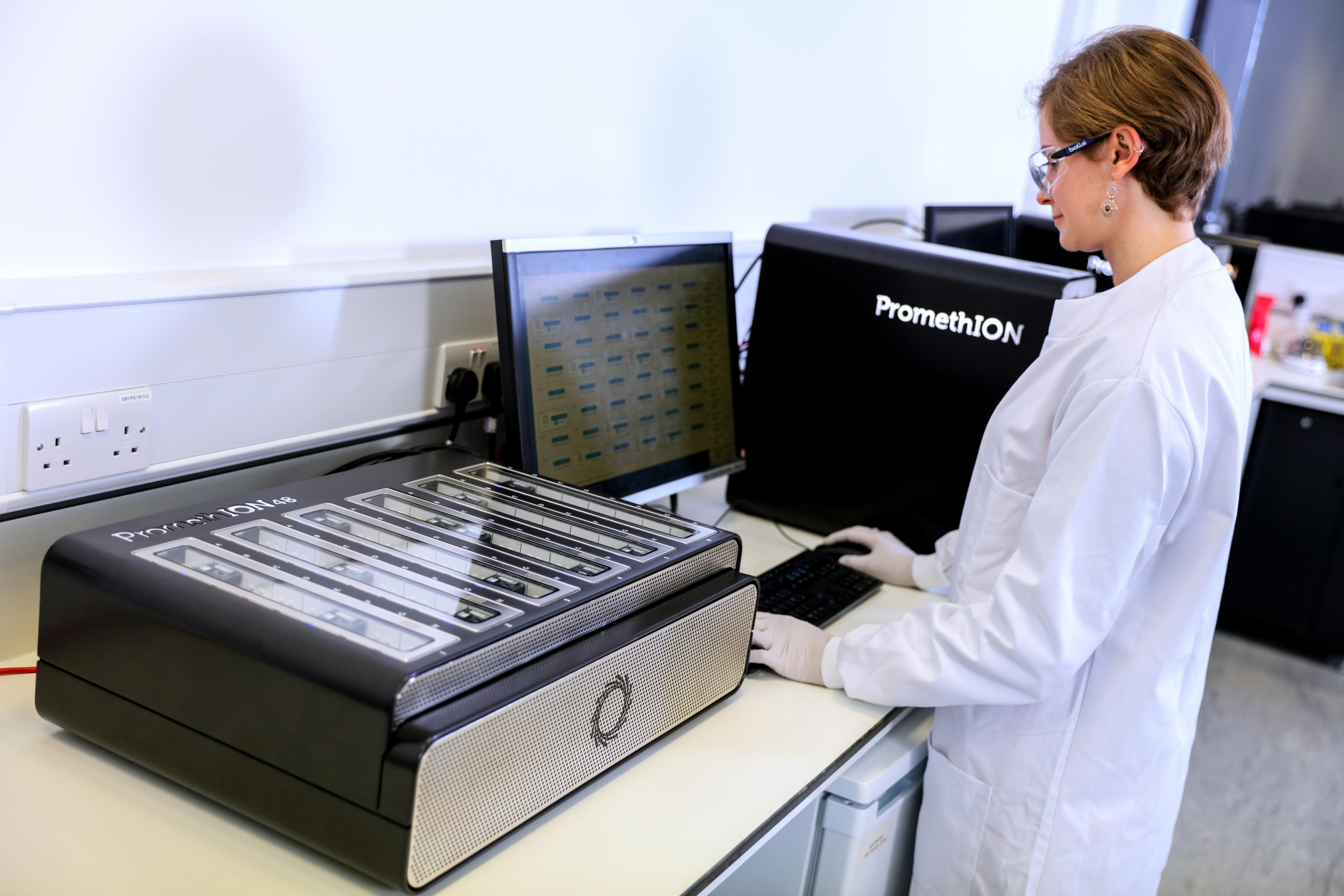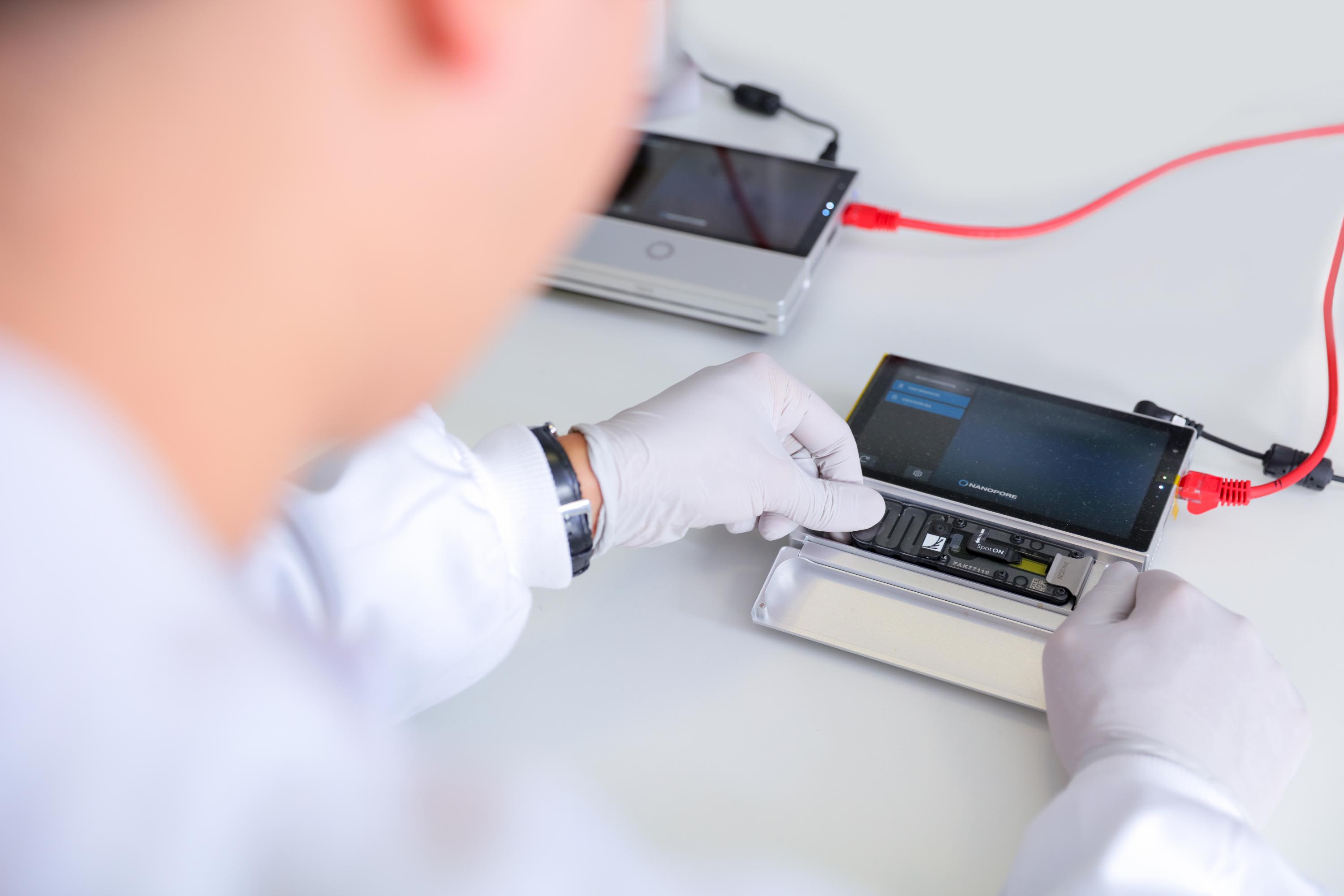A revolution in analysis
Oxford Nanopore is on a mission to empower scientists to analyse anything, anywhere

The equipment scientists have traditionally needed to perform genetic analysis on research samples is often bulky and expensive.
So, Oxford Nanopore has pioneered the use of tiny pores to develop tools for genetic analysis.
Oxford Nanopore is one of the city’s greatest innovation success stories to date. Formed in 2005, and floated on the London Stock Exchange in 2021, it has disrupted the genetic analysis industry with a revolutionary, cost-effective system that is so portable it can either sit on a desk or be taken into the field.
Additionally, Oxford Nanopore’s devices are hundreds to thousands of times faster than any other product on the market so they can provide rapid insights with real time data streaming.
Scientists have traditionally needed large, expensive equipment for genetic sequencing and molecular analysis. These instruments are too large to travel with a scientist on location, and their high cost means they are only available to institutions and businesses with large budgets.
Rather than rely on costly and cumbersome optics technology, as used by competitors, Oxford Nanopore’s desktop devices work by passing a tiny electric current through a tiny hole or ‘nanopore’ located in a membrane. An individual molecule or building block of a polymer passing through the pore alters the current in its own unique way, allowing it to be identified.
Nanopore sensing of small molecules was demonstrated by Professor Hagan Bayley's laboratory in the early 1990s. The idea that nanopores might be used to sequence DNA can be traced back to an idea written down on a piece of paper in 1989 by Professor David Deamer then at UC Davis.
In 2005, Bayley joined forces with Dr Gordon Sanghera and Dr Spike Willcocks to form Oxford Nanolabs to develop the sensing technology and soon afterwards nanopore sequencing, and then commercialise them.
Sanghera remains as Chief Executive Officer and Willcocks as Chief Strategy Officer at Oxford Nanopore (the name was changed in 2008), while Bayley is pursuing an academic career as Professor of Chemical Biology at the University of Oxford.

Bayley explains that now nanopore technology has been proven and consistently improved by Oxford Nanopore since 2005, its capabilities are growing beyond DNA and RNA sequencing with which the company has been traditionally associated.
'The idea of the original nanopore technology was that if something happens inside the pore, if something binds inside there, if a chemical reaction occurs, if a polymer passes through the pore, it will change the associated current,' he says.
'So, the technology can look at small molecules, it can look at chemical reactions, it can look at sugars, proteins, drug molecules – you name it; it’s not just DNA and RNA.'
Bright minds

Building the company and developing the science into viable technology has taken a vast array of talent. It is here Professor Bayley believes access to postgraduates from the University has played a vital role in pushing the boundaries of what the nanopore system can deliver.
Dr Jayne Wallace is a good example. She was attracted to Oxford University for postdoctoral research because it is world-renowned in molecular biology.
It was during her four years of postdoctoral research that she realised Oxford Nanopore would be a perfect avenue to extend her area of research from academia into industry.
Since joining in 2010, she has become the Director of Nanopore Research, leading a team that is constantly seeking to refine the size, shape and chemical make-up of protein nanopores, so that they can be engineered to suit a variety of applications.

She credits Oxford Nanopore for allowing her to dive into research projects that are rewarding because they have real impact in the outside world, beyond the laboratory.
'I’m driven by scientific research and what we do at Oxford Nanopore is so cutting edge,' she says.
'It really is amazing to work on something that can have such a huge impact on society. We’re not relying on established methods, such as optics, which require big detectors.
Our devices rely on electrical recordings which means they’re much smaller and far more portable and cost-effective. That opens up sequencing to the masses, rather than just big sequencing centres.'
Protein sequencing goal

Dr Sandra Ionescu was similarly drawn to study at Oxford, from her native Florida, after winning a scholarship to study for a Master’s degree. Rather than return home, though, she stayed on in the city to earn a DPhil in Chemical Biology with Professor Bayley. The decision was based on the University offering not only world-renowned research opportunities, but also the network it provides into local and global businesses, such as Oxford Nanopore.
'Oxford is extremely international, and the education is world class, but I think one of the biggest advantages of studying here is the network you build'
'While I was President of the Chemistry Club, we had many external companies deliver speeches and introduce us to research within their industry. There are also numerous spinouts, with three science parks in the vicinity of Oxford. I don't think you’d come across many places where the science and diversity of people you meet is so concentrated.'
This network led her to join Oxford Nanopore as part of a research team working on expanding the platform’s ability to detect the building blocks of proteins towards protein sequencing. This is a complicated addition to its current capabilities because proteins are far more complex than DNA and RNA, she explains.

Dr Sandra Ionescu
Dr Sandra Ionescu
'Proteins are made up of twenty different building blocks rather than four (like DNA),' says Dr Ionescu.
'Those twenty blocks can then be modified in hundreds of different ways, which makes interpreting the signal proteins produce a lot more complex. Many of these modifications are relevant to the diagnosis and treatment of diseases. We’re putting in a lot of work to understand and improve the signal to make protein sequencing a reality.'

Three steps to success

While the researchers work on constantly improving the company’s technology, Oxford Nanopore devices are already in use in over 120 countries around the world, helping scientists answer questions about the biology of people, animals, plants and pathogens. They are increasingly being used in industry, particularly in clinical research, conservation, epidemiology and food safety.
It is an impressive increase in performance since the earliest idea was investigated by Professor Bayley. He believes the fact that he has not been involved in the day-to-day running of the company, even in its early days, is testament to how researchers at the University of Oxford are supported to carry on pursuing their areas of passion, rather than feeling compelled to leave to run a company.
That is only at the start, of course, and the fact that Oxford Nanopore has since gone on to achieve so much since 2005, including its floatation last Autumn, is down to a talented management team and gifted researchers who have proven the technology and then consistently improved it. According to Bayley it is these talented people who are at the heart of three key ingredients that contribute to a successful innovation business.

'First of all, you've got to have some really good science,' he says.
'You need places like the University of Oxford, that give freedom to operate in terms of research to realise new ideas that can be turned into something practical in the end.
'Second, you need the right kind of people involved in the business: like Gordon Sanghera and Spike Willcocks, and terrific young scientists.
Then third, none of this will work unless you have the right ecosystem. If you don't have experienced mentors around, if you don't have the technology parks around, if the people you need are all 150 miles away, it's just not going to work.'
An inspiration for Oxford, and beyond

For Professor Chas Bountra, Pro-Vice-Chancellor of Innovation at the University of Oxford, the story of Oxford Nanopore is a shining example of what the city can achieve when the right people and the right science come together and attract the financing to build something inspiring.

Professor Chas Bountra
Professor Chas Bountra
He believes Oxford Nanopore is just such an example of what happens when a 'rock star' CEO dedicates a talented team to turn science into a winning business. As more start-ups are inspired by the company’s story, he believes Oxford’s innovation standing will go from strength to strength.
'I want Oxford to be the innovation hub of Europe'
We are not short of great people with step-changing ideas. We have a wonderful global alumni, industry and philanthropy network, and a brand name that allows us to aggregate great teams. We need to attract more investors and create more innovation space in Oxford. We also need more ‘scale up entrepreneurs’ to rapidly grow the next generation of 10 to 30 billion pound companies.
'The CEO of Nanopore is a super star – Gordon Sanghera. He was determined not to IPO (list publicly) in the US but rather to do so in the United Kingdom. Oxford Nanopore is an amazing success story for the city. Our job now is to build on this momentum and help develop more innovative companies that disrupt industries, do accelerated IPOs, create new industries, and transform the lives of people all over the world.'
Inspired by our innovators?
Get in touch with collaboration@admin.ox.ac.uk or visit https://www.ox.ac.uk/research/engage-with-us to see how we could help you make a difference.


